Enroll User Devices for Management
You need to enroll devices to Endpoint Manager in order to manage those devices going forward. Reminder - you must first have added users before you can add their devices.
- Click 'Users' > 'User List' > select users > click 'Enroll Device'.
Complete the wizard to send device enrollment mail to your users. Usersmust open the mail on the device itself. See the tutorial below.
- The mail contains
an enrollment token. Multiple devices can be enrolled with thesame token by the user simply responding to the mail from each device. Each token is valid for 90 days.
- Each license covers one device per user.
You will need additional licenses for each device you add for a user. See Manage Licenses if you need help with this.
- You can also bulk enroll
users and Windows endpoints by creating a software installation policy in Active Directory (AD). See Enroll Windows Devices Via AD Group Policy and 'Import User Groups from LDAP' for more details.
- You can also enroll iOS devices using your Apple DEP account. See 'Integrate Apple DEP with Endpoint Manager'
- This section explains how to enroll devices for multiple users
Tutorial
- Click 'Users' > 'User List' on the left
- Select the users for whom you want to add devices
Or
- Click the 'Add'
button the menu bar then 'Enroll Device'. on
on
This starts step 1 of the device enrollment wizard:
- Enroll by customer - Enrolls the device you
are currently using. You may disregardthis option at this stage as we are adding multiple devices with the 'Other device' option.
- Enroll by user -
Add devices owned by the users you selected previously. Those users should already be listed in the 'Specify User' box:
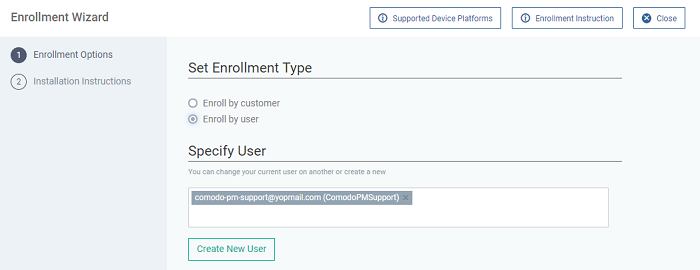
You can add additional, existing users by simply typing theiremail address in the box. Endpoint Manager will auto-suggest usersthat have already been created.
- Create New User - Click if you want
to add a new user to Endpoint Manager. You cannot add devicesunless you have first added the users that own them. The add-userprocess is explained here.
- Click 'Next' to proceed to step 2.
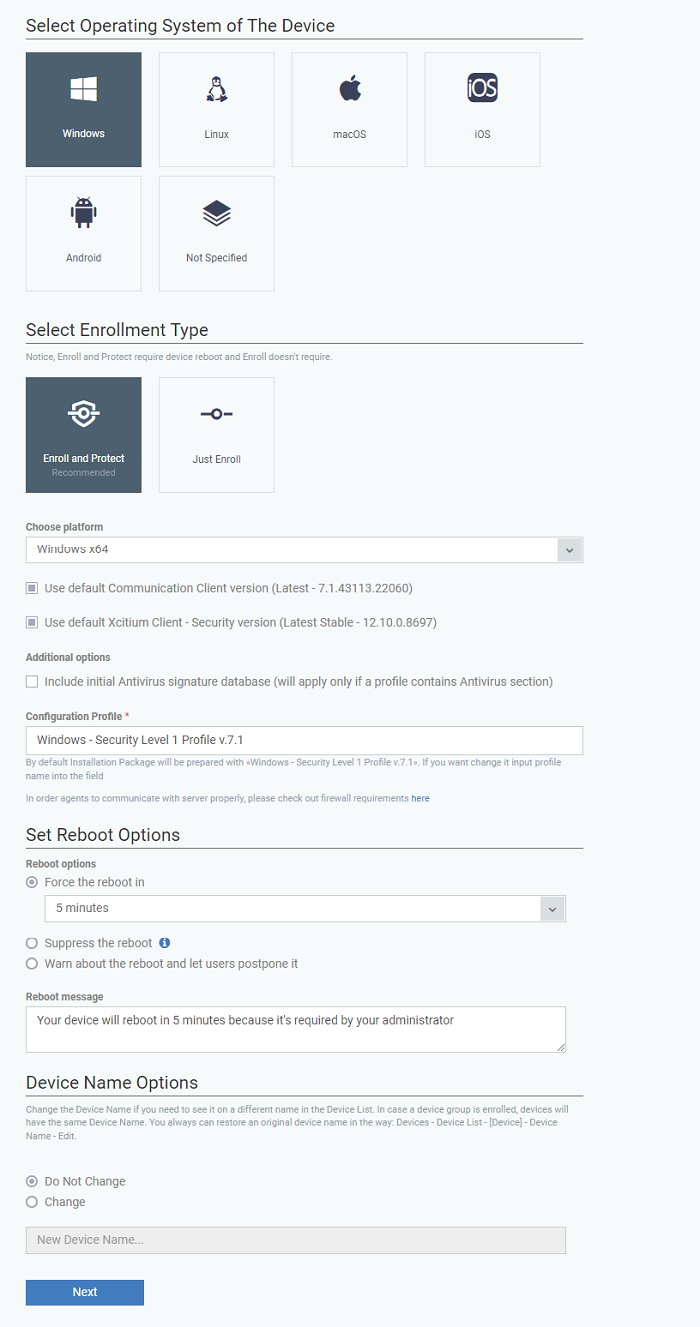
TLDR-
- Click ‘Not Specified’ if you only want to install the communication client on target devices. The wizard will detect the target operating system and send the appropriate client to the device user.
- Click one of the operating system tiles if you also want to install the security client. Make sure the target devices use the operating system you selected.
There are two broad ways you can enroll devices:
Option 1 - Enroll + Protect - Single Operating System
- Click one of the operating system boxes to enroll devices of that type. Please make sure all your target devices use this operating system.
- The wizard will send enrollment mails that only provision the OS you choose. For example - If you select the ‘Windows’ box, then the wizard will send enrollment mails which only contain download links for the Windows clients.
Once you have chosen the OS, you can customize enrollment optionsas required . You can configure items such as enrollment type,reboot policy , client version, configuration profileand device name.
Option 2 - Enroll Only - Multiple Operating Systems
Click the ‘Not Specified’ box. This option installs onlythe communication client, and doesn’t install the security client.
Your target devices can be a mix of operating systems rather than a single OS. This option auto-detects the OS of the device andemails the appropriate client link to the user.
The latest version of the communication client is installed oneach device . The MDM profile is installed on MAC devices
- Note – You can use this option to quickly connect devices to Endpoint Manager, then go back later and install the security client
if required .
Enrollment Type
Applies to Windows, Mac
Enroll and Protect – Installsboth the communication client and the security client.
- Just Enroll – Installs only the communication client
Background. There are two types of client:
- Communication Client –
Connects the device to Endpoint Manager for central management. Itis mandatory to install this client.
- Security Client –
This is the security software. Depending on the operating system,it includes antivirus, firewall, threat-containment, web-filtering,and more . It is optional to install this client.
Click 'Next' to skip to step 3 if you are happy with your choices on this page.
OR
Use the following links to read more about the various settings per OS:
|
Setting |
Description |
|---|---|
|
Choose platform |
Select
|
|
Use default Communication Client version |
This client enrolls the endpoint for central management.
|
|
Use default Communication Client Security version |
This client installs security software such as antivirus, firewall and auto-containment.
|
|
Additional options |
AV Database - Choose whether to include the latest virus database with the installation package. This increases the size of the package. If disabled, the |
|
Configuration Profile |
A configuration profile is a collection of settings which specify a device's network access rights, security settings, antivirus scan schedule, and more. The default is 'Windows - Security Level 1' profile. Choose a different profile if required.
|
|
Set Reboot Options |
Endpoints need to be restarted to complete CCS installation. You have the following restart options:
|
|
Device Name Options |
|
- Click 'Next' to proceed to step 3
|
Setting |
Description |
|---|---|
|
Choose platform |
Select Linux OS version
‘Hybrid’ just means the package is suitable for both types of OS. |
|
Device Name Options |
|
- Click 'Next' to proceed to step 3
|
Setting |
Description |
|---|---|
|
Select Method |
|
|
Device Name Options |
|
- Click 'Next' to proceed to step 3
- Device Name Options:
- Do Not Change - The device’s existing name
is used to identify the device inEndpoint Manager.
- Change - Enter a new device name. Note – You can restore the
original name from the device list screenif required
- Click 'Next' to proceed to step 3
Step 3 – Installation Instructions
The final step is to send out the enrollment emails to the device owners:
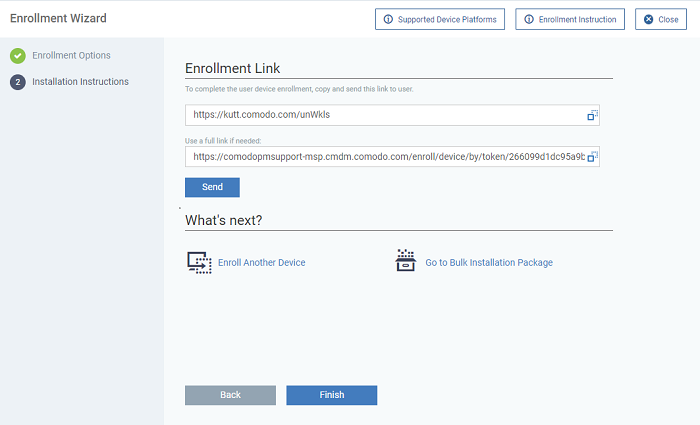
- Send - Click this to send enrollment mails to users with the settings you choose in steps 1, 2 and 3.
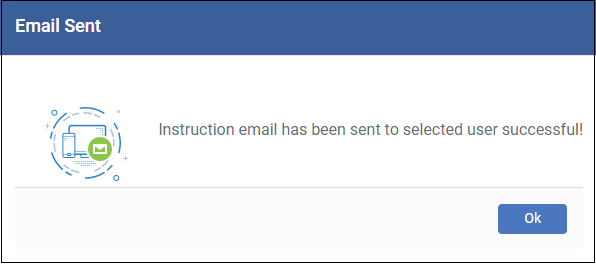
- Enroll Another Device – Takes you back to step 1
Go to Bulk Installation Package – Takes you to bulk installation package screen to configureand enroll users in bulk. See 'Bulk Enrollment of Devices'
- Click 'Finish' to close the window.
Note – If you chose 'Current Device' in step 1, then you can enroll your device in two ways:
-
Download the client in the final step.
Follow the instructions and complete the enrollment procedure. -
Click 'Enrollment Instructions' at top-right, click the
appropriate enrollment link to your device and complete the procedure.
An
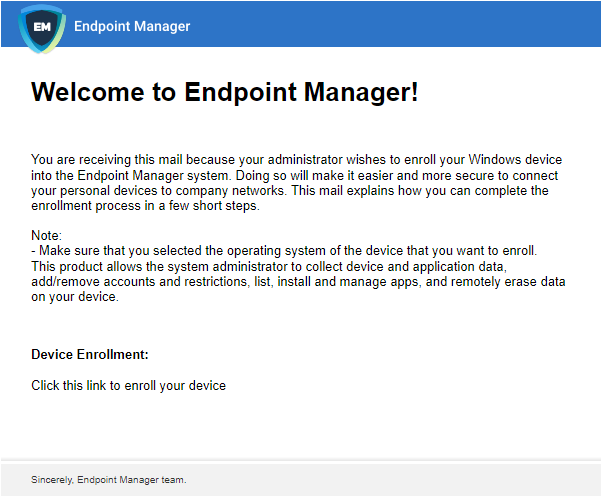
- Clicking the link will take the user to a page which lets them download the appropriate communication client/profile:
- Click 'Users' > 'User List' > click the name of a user to open their details screen > click 'Enroll Device'
- Click 'Devices' > 'Device List' > 'Enroll Device'
The following sections contain help per device operating system:
|
Note – See Appendix 1a and Appendix 1b for a list of ports that Endpoint Manager uses to communicate with endpoints and Comodo servers. |


